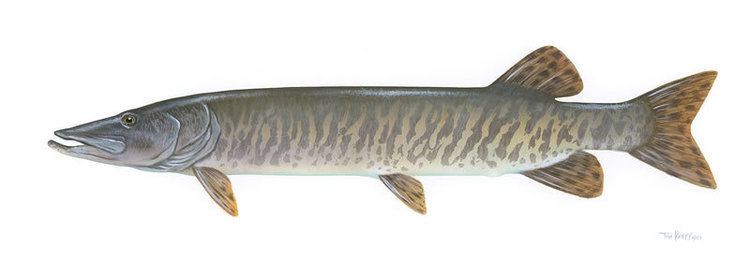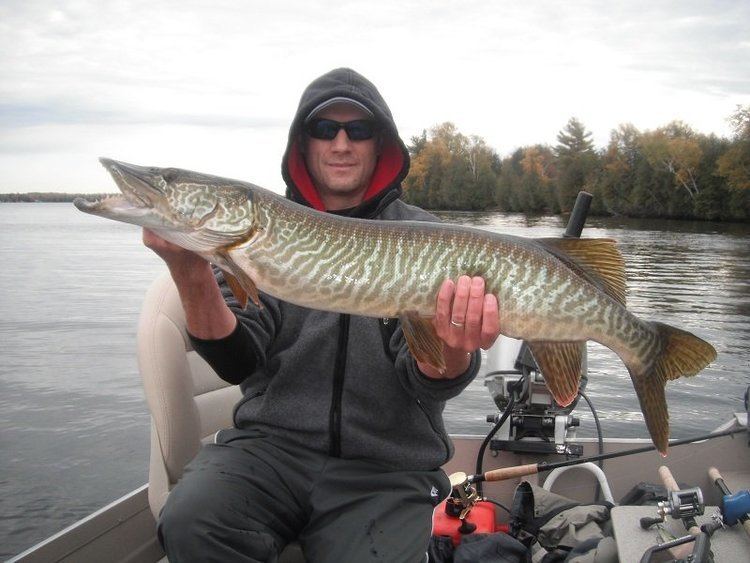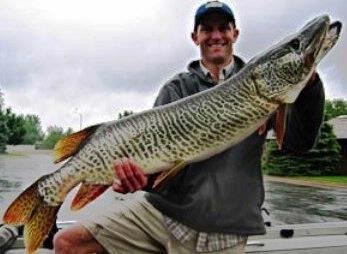Superorder Protacanthopterygii Rank Hybrid | Subphylum Vertebrata Family Esocidae Phylum Chordata | |
 | ||
Species Esox masquinongy × luciusor Esox lucius × masquinongy Scientific name Esox masquinongy X Esox lucius Found in Oneida Lake, Smithville Lake, Lake James Similar Muskellunge, Esox, Yellow perch, Chain pickerel, Black crappie | ||
The tiger muskellunge (Esox masquinongy × lucius or Esox lucius × masquinongy), commonly called tiger muskie, is a carnivorous fish, and is the usually-sterile, hybrid offspring of the true muskellunge (Esox masquinongy) and the northern pike (Esox lucius). It lives in fresh water and its range extends to Canada, the Northeast, and the Midwest United States. It grows quickly; in one study, tiger muskie grew 1.5 times as fast as muskellunge. Like other hybrid species, tiger muskie are said to have "hybrid vigor," meaning they grow faster and stronger than the parent fish, and are also less susceptible to disease. Trophy specimens weigh about 30 lb. Its main diet is fish and small birds. The tiger muskie and the muskie are called the fish of 10,000 casts due to the challenge involved in catching them.
Contents

Distribution

The tiger muskie lives in the lakes and quiet rivers in Canada, the Great Lakes, the Upper Mississippi Valley, and the Ohio and St. Lawrence Rivers. It is rarely found far from its natural waters except for stocked fish. Several states, including Minnesota, Michigan, New Hampshire, Washington, Massachusetts, Arkansas, Montana, Idaho, Utah, Colorado, New Mexico, and Wyoming stock tiger muskies. Each tiger muskie tends to inhabit the same areas of its lake from year to year. It tends toward shallower waters (6–9 ft deep) and travels half as much in the summer and fall than it does in the winter to spring, when it prefers deeper waters (15–30 ft deep).
Characteristics

The tiger muskie is the result of the true muskellunge (Esox masquinongy) and the northern pike (Esox lucius) interbreeding. The tiger muskie has some of the characteristics of both fish. Tiger muskie, like pike and muskellunge, have long, cylindrical-shaped bodies. Their dorsal and ventral fins are located far back near the tail and are lobe-shaped. The caudal fins of the tail are more rounded than those of true muskies.They have skinny and compressed heads and the bottom jaw is elongated with an upward curve, known as a duckbill-shape. Its pattern is varying amounts of color with vertical dark stripes and spots on a light background, the opposite color scheme of a northern pike. The tiger muskie has 5 or 6 chin pores per side on the lower jaw.
Diet

The tiger muskie feeds as the northern pike and muskellunge do, by waiting near weeds and ambushing its prey. They have food preferences similar to those of the true muskie and northern pike as well. They seem to prefer larger fish during the summer and fall months in preparation for the winter months. During the winter and spring months they prey on smaller easier targets due to their slow metabolism. Its varied diet includes yellow perch, suckers, golden shiners, walleye, smallmouth bass, and various other types of fish. When fish are not readily available tiger muskies will feed on crayfish, frogs, ducklings, muskrats, mice, other small mammals, and small birds.
Growth and survival
State-record tiger muskie catches are recorded as 20-50 lb depending on the state, with northern states yielding larger specimens.
Because tiger muskies are bred for stocking purposes, studies have been made of its growth rate and the factors that affect it. The growth rate of juveniles depends on the water temperature and the type of feed. In studies, the tiger muskie has had the highest growth, production, and food conversion efficiency at temperatures of 68–75°F (20–24°C). Below these temperatures, growth rates slow and above them cannibalism increases.
Several studies have examined the effect of stocking size on survival of stocked tiger muskellunge. This information helps those involved in wildlife management to make cost-effective decisions about breeding and stocking programs. Larger size at stocking has been correlated with higher survival rates and the effect is large enough that it is usually cost-effective to stock larger juveniles (180 – 205 mm)
As tiger muskies grow longer, they increase in weight. The nonlinear relationship between total length (L, in inches) and total weight (W, in pounds) for nearly all species of fish can be expressed by an equation of the form:
Invariably, b is close to 3.0 for all species, and c is a constant that varies among species. A relationship based on 27 populations of tiger muskie from 9 states was used to develop a specific equation for tiger muskie and computed that c = 0.00008035 and b = 3.337. This relationship predicts that a 33-inch tiger muskie will weigh about 10 lb, and a 47-inch tiger muskie will weigh about 30 lb.
Reproduction
Cross-breeding of the true muskellunge and the northern pike occurs naturally in the wild where both parent species occur. The tiger muskie is sterile, which is not unusual for a hybrid fish. Breeders prefer to breed male northern pike and female muskellunge, because the eggs are less adhesive and have less tendency to clump when hatching. While some tiger muskie occur naturally most are bred in hatcheries. Tiger muskie usually grow more quickly than the pure-strain muskie and northern pike in the first several years. They can also endure high temperatures better than the parent fish and they grow more quickly reaching legal size sooner, making them more useful in stocking.
Angling
The tiger muskie was caught frequently in the past by anglers who did not know and did not care what they were catching, as long as the fish tasted good. Now, the tiger muskie is stocked regularly in some lakes, and people go to great lengths to obtain a tiger muskie, but it is not an easy fish to catch. Some people say that it takes 10,000 casts to catch one. The current world record tiger muskie was caught by John Knobla on Lac Vieux Desert.ref>
Sport
The tiger muskie is renowned as a sport fish because it can reach sizes over 50 inches long. They can be caught in lakes and reservoirs in locations with plenty of forage. Being a large powerful fish, they can be difficult to manage. The best way to catch a tiger muskie is to get the fish to the side of the boat as quickly as possible so the fish does not become exhausted, this is important during the summer months. Using a large landing net, scoop the fish onto the boat making sure it does not flop around too much; fish often hurt themselves by thrashing wildly in boats. Quickly grip over the top of the gill plates, but be careful of the gills because they can tear easily and are very sharp. Make sure to use pliers when removing the hook because they have many sharp teeth.
Like many other predatory fish, Muskie like to hide in the edge of weed beds so they can ambush prey. They can also be found in areas where they have quick access to open parts of the lake. Unlike other fish muskie seem to feed when the weather and atmospheric pressure stay consistent, rain or shine. Catching tiger muskie is usually done by trolling at speeds between 4 and 6 miles per hour, but they have been caught trolling faster and slower.
Contrary to popular folklore, muskie will hit at any size fishing lure. The lure does not have to be huge. The lure size should vary depending on the amount of weeds in the area or the depth you wish to fish at. In open water, it is suggested to use a larger lure; such as, Jointed Rapalas, Loke Lures, Ziggy Lures, Willy Lures, Wiley Lures, Large Mepps Bucktails, Muskie Plugs, large spinner baits or long shallow running Rapalas. On average Fire-Tiger and Perch-color work best during the day time and red lures work better in the evening.
When fishing in weeds it is better to use smaller lures. 4 to 5 inch Original Floating Rapalas, or Thundersticks work very well. Smaller Jointed Rapalas and smaller spinner baits are effective too.
